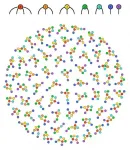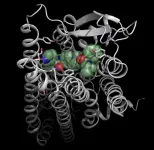Monitoring the body's fat burning by breath
2021-02-10
(Press-News.org) Your breath holds the key to monitoring fat burning, and now a research group from Tohoku University has created a compact and low-cost device that can measure how our body metabolizes fat.
The device uses an ultraviolet lamp to gauge exhaled acetone gas, which is produced in the blood through the metabolic reaction of fat.
"Precise measurements of acetone gas concentration allows us to determine the body's ability to metabolize fat and develop exercise methods for efficient fat burning," says Professor Yuji Matsuura from Tohoku University's Graduate School of Biomedical Engineering, who led the research group.
The details of their study were published in the journal Sensors on January 12, 2021
Matsuura and his team focused on ultraviolet light, which due to its extremely short wavelength is strongly absorbed by acetone gas. They succeeded in measuring the acetone concentration with high accuracy: 0.03 ppm--while the acetone concentration is about 1 ppm in exhaled air.
To do this, they trapped exhaled air in a thin tubular optical fiber--called a hollow optical fiber--that had been exposed to vacuum ultraviolet light produced from an ultraviolet lamp. The group measured the degree to which the light is weakened as a result of the absorption of acetone gases to ascertain the acetone gas concentration.
When putting the device to use the group discovered that fat burning rates gradually increased after exercise. In contrast, the rate remained constant during exercise, indicating that a substantial part of fat metabolization occurs after exercise.
Until now, a large mass spectrometer was required to monitor fat metabolization. The new device, however, comprises only three components: a lamp, a hollow optical fiber, and a small spectrometer making it compact and low cost.
"The present research may also lead to non-invasive diagnosis methods for diabetes, since diabetic patients have high concentrations of acetone gas in their breath," added Matsuura.
INFORMATION:
[Attachments] See images for this press release:

ELSE PRESS RELEASES FROM THIS DATE:
2021-02-10
Many natural and human-made networks, such as computer, biological or social networks have a connectivity structure that critically shapes their behavior. The academic field of network science is concerned with analyzing such real-world complex networks and understanding how their structure influences their function or behavior. Examples are the vascular network of our bodies, the network of neurons in our brain, or the network of how an epidemic is spreading through a society.
The need for reliable null models
The analysis of such networks often focuses on finding interesting properties and features. For example, does the structure of a particular contact network help diseases spread ...
2021-02-10
The research team led by Masakazu Ohara, graduate student of the Department of Computer Science and Engineering at Toyohashi University of Technology (student in the Leading Program doctoral program); Associate Professor Kowa Koida of the Electronics-Inspired Interdisciplinary Research Institute; and Associate Professor Juno Kim of the University of New South Wales (Australia) discovered that when people judge the thickness of an object, objects with glass-like transparent optical properties are perceived to be flatter than they actually are. It was previously known that objects made of metallic or glossy materials are perceived to be thicker than what they are, but now the current research has identified that transparent ...
2021-02-10
A description of gravity compatible with the principles of quantum mechanics has long been a widely pursued goal in physics. Existing theories of this 'quantum gravity' often involve mathematical corrections to Heisenberg's Uncertainty Principle (HUP), which quantifies the inherent limits in the accuracy of any quantum measurement. These corrections arise when gravitational interactions are considered, leading to a 'Generalized Uncertainty Principle' (GUP). Two specific GUP models are often used: the first modifies the HUP with a linear correction, while the second introduces a quadratic one. Through new research published in EPJ C, Serena Giardino and Vincenzo ...
2021-02-10
A unique 'heart-shape', with wisps of gas filaments showing an intricate honeycomb-like arrangement, has been discovered at the centre of the iconic supernova remnant, the Crab Nebula. Astronomers have mapped the void in unprecedented detail, creating a realistic three-dimensional reconstruction. The new work is published in Monthly Notices of the Royal Astronomical Society.
The Crab, formally known as Messier 1, exploded as a dramatic supernova in 1054 CE, and was observed over the subsequent months and years by ancient astronomers across the ...
2021-02-10
Dimerization (Note: combination of two identical or different molecules) of the human neuropeptides oxytocin and vasopressin can produce new types of bioactive molecules. In a recent study, an international research team led by MedUni Vienna and the University of Vienna demonstrated that dimerized and therefore significantly larger versions of oxytocin and vasopressin are still able to activate their receptors. Such new constructs provide several opportunities to optimize the efficacy of these neuropeptides for therapeutic application. The researchers were inspired for this approach from naturally occurring dimers. The results have been published in the journal "Chemical Science".
Oxytocin/vasopressin receptors are typical examples of so-called G protein-coupled receptors - the most ...
2021-02-10
In order for a drug to be effective at the right places in the body, it helps if scientists can predict as accurately as possible how the molecules of that drug will interact with human cells. In a joint research project, scientists from Collaborative Research Centre 1423 at Leipzig University and the Chinese Academy of Sciences in Shanghai have succeeded in elucidating such a structure, namely that of the neuropeptide Y receptor Y2 with one of its ligands. This is the first time that a molecular blueprint for this receptor is available, which will enable the development of tailor-made new drugs, for example to treat epilepsy or cardiovascular diseases. The researchers' findings have now been published in Nature Communications.
The Y2 receptor plays ...
2021-02-10
"Insulin is a prime example for a successful peptide drug that has been essential for the health of millions of diabetic patients in the past 100 years," says Markus Muttenthaler, who leads research groups at the Institute of Biological Chemistry of the Faculty of Chemistry at University in Vienna as well as at the Institute for Molecular Bioscience, at the University of Queensland in Brisbane.
Worldwide, peptide therapeutics account for 5% of the global pharmaceutical market, with global sales exceeding US$ 50 billion. More than 150 peptides are in clinical development and another 400-600 peptides undergoing preclinical ...
2021-02-10
Children with epilepsy sleep poorly compared to healthy children, and are more likely to experience disruptions such as night terrors, sleep walking or sleep disordered breathing, according to a new study.
A team at the University of Birmingham's Centre for Human Brain Health analysed 19 published studies on sleep and epilepsy in children and adolescents to try to better understand and articulate the links between them.
Their findings, published in Sleep Medicine Reviews, highlight the significantly poorer sleep experienced by children and adolescents with epilepsy, and present a strong argument for screening children for sleep problems as an integral part of diagnosis and management of the condition.
Lead author Alice Winsor explains: "We know that sleep and epilepsy ...
2021-02-10
Among the most active fields of research in modern physics, both at an academic level and beyond, are quantum computation and communication, which apply quantum phenomena such as superposition and entanglement to perform calculations, or to exchange information. A number of research groups around the world have built quantum devices that are able to perform calculations faster than any classical computer. Yet, there is still a long way to go before these devices can be converted into marketable quantum computers. One reason for this is that both quantum computation and ...
2021-02-10
A new study shows that proteins called IAPs, which can trigger programmed cell death, are inhibited by a specific chemical modification, and reveals that they play a wider role in protein quality control than previously assumed.
N-terminal acetylation - the attachment of an acetyl group (CH3-COO-) directly to the N-terminus of a protein - is one of the most common modifications found in the protein complements of higher organisms. The chemical tag has been linked to a wide variety of cellular signaling pathways. Now researchers led by Tanja Bange (Institute of Medical Psychology, Ludwig-Maximilians-Universitaet (LMU) in Munich) have shown that N-terminal acetylation shields certain proteins from degradation, and inhibits programmed cell death ('apoptosis'). ...
LAST 30 PRESS RELEASES:
[Press-News.org] Monitoring the body's fat burning by breath



